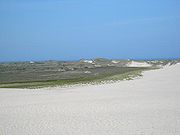
Råbjerg Mile
Encyclopedia


Dune
In physical geography, a dune is a hill of sand built by wind. Dunes occur in different forms and sizes, formed by interaction with the wind. Most kinds of dunes are longer on the windward side where the sand is pushed up the dune and have a shorter "slip face" in the lee of the wind...
between Skagen
Skagen
Skagen is a projection of land and a town, with a population of 8,515 , in Region Nordjylland on the northernmost tip of Vendsyssel-Thy, a part of the Jutland peninsula in northern Denmark...
and Frederikshavn
Frederikshavn
This article is about a Danish town. For the German town, see Friedrichshafen, and for the Finnish town, see Fredrikshamn .Frederikshavn is a Danish town in Frederikshavn municipality, Region Nordjylland on the northeast coast of the Jutland peninsula in northern Denmark. Its name translates to...
, Denmark
Denmark
Denmark is a Scandinavian country in Northern Europe. The countries of Denmark and Greenland, as well as the Faroe Islands, constitute the Kingdom of Denmark . It is the southernmost of the Nordic countries, southwest of Sweden and south of Norway, and bordered to the south by Germany. Denmark...
. It is the largest moving dune in Northern Europe with an area of around 1 km² (0.4 mi²) and a height of 40 m (130 ft). The dune contains a total of 4 million m³ of sand.
The wind moves it in a north-easterly direction up to 18 m a year. The dune leaves a low, moist layer of sand behind it, trailing back westwards towards Skagerrak
Skagerrak
The Skagerrak is a strait running between Norway and the southwest coast of Sweden and the Jutland peninsula of Denmark, connecting the North Sea and the Kattegat sea area, which leads to the Baltic Sea.-Name:...
, where the Mile originally formed more than 300 years ago. Over 250,000 people visit the dune every year.
In northern Jutland
Jutland
Jutland , historically also called Cimbria, is the name of the peninsula that juts out in Northern Europe toward the rest of Scandinavia, forming the mainland part of Denmark. It has the North Sea to its west, Kattegat and Skagerrak to its north, the Baltic Sea to its east, and the Danish–German...
in the 16th and 17th centuries shifting dunes were a problem for the population: huge dunes, some stretching up to 7 km (4 mi) inland drove them back from the coastal areas, but in the 19th century the government acted to alleviate the problem. The Sand Drift Act of 1857 allowed the state to buy or expropriate areas of sand drift, and a further Act in 1857 allowed the purchase of areas adjacent to the drifts. Dune grasses and conifers were planted to stabilize the sands and these plantations became common after 1880. Although barren, the dune zone allowed limited sheep farming and some inshore fishing. By the 1950s the dune drifts were under control.

The area is an internationally important staging site for migrating raptors
Bird of prey
Birds of prey are birds that hunt for food primarily on the wing, using their keen senses, especially vision. They are defined as birds that primarily hunt vertebrates, including other birds. Their talons and beaks tend to be relatively large, powerful and adapted for tearing and/or piercing flesh....
and a breeding site for the Eurasian Golden Plover
Eurasian Golden Plover
The European Golden Plover is a largish plover. This species is similar to two other golden plovers. American Golden Plover, Pluvialis dominiica, and Pacific Golden Plover, Pluvialis fulva, are both smaller, slimmer and relatively longer-legged than European Golden Plover, and both have grey...
(Pluvialis apricaria) and the Wood Sandpiper
Wood Sandpiper
The Wood Sandpiper, Tringa glareola, is a small wader. This Eurasian species is the smallest of the shanks, which are mid-sized long-legged waders of the family Scolopacidae.- Description and systematics :...
(Tringa glareola).

